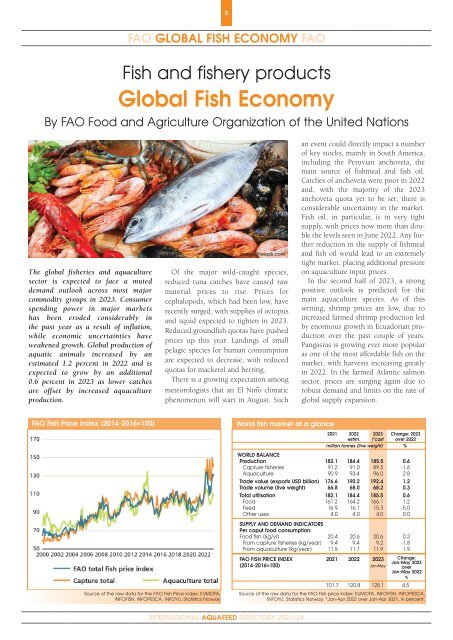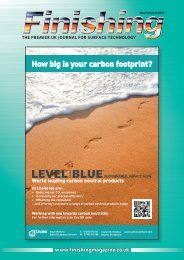International Aquafeed Directory 2023-24
Welcome to the 27th edition of the International Aquafeed Directory & Buyers’ Guide 2023/24, the essential guide for everyone involved in the global aquafeed industry. Last year I wrote about the effects of the war, and the challenges resulting from rising fuel costs, but the industry showed great resilience. The impact of inflation and reduced consumer spending dampened growth in the market at the beginning of the year, but an expected increase in aquaculture production will compensate for a mall decline in wild catches. This edition contains information relating to 450+ businesses and over 850 products, coupled with useful and practical information including the extruder and expander guide. We would like to take this opportunity to thank all the businesses that have contributed to the completion of this directory. I also hope that all of our readers across the world remain safe and well.
Welcome to the 27th edition of the International Aquafeed Directory & Buyers’ Guide 2023/24, the essential guide for everyone involved in the global aquafeed industry.
Last year I wrote about the effects of the war, and the challenges resulting from rising fuel costs, but the industry showed great resilience. The impact of inflation and reduced consumer spending dampened growth in the market at the beginning of the year, but an expected increase in aquaculture production will compensate for a mall decline in wild catches.
This edition contains information relating to 450+ businesses and over 850 products, coupled with useful and practical information including the extruder and expander guide.
We would like to take this opportunity to thank all the businesses that have contributed to the completion of this directory. I also hope that all of our readers across the world remain safe and well.
You also want an ePaper? Increase the reach of your titles
YUMPU automatically turns print PDFs into web optimized ePapers that Google loves.
5<br />
FAO GLOBAL FISH ECONOMY FAO<br />
Fish and fishery products<br />
Global Fish Economy<br />
By FAO Food and Agriculture Organization of the United Nations<br />
The global fisheries and aquaculture<br />
sector is expected to face a muted<br />
demand outlook across most major<br />
commodity groups in <strong>2023</strong>. Consumer<br />
spending power in major markets<br />
has been eroded considerably in<br />
the past year as a result of inflation,<br />
while economic uncertainties have<br />
weakened growth. Global production of<br />
aquatic animals increased by an<br />
estimated 1.2 percent in 2022 and is<br />
expected to grow by an additional<br />
0.6 percent in <strong>2023</strong> as lower catches<br />
are offset by increased aquaculture<br />
production.<br />
image: Freepik.com<br />
Of the major wild-caught species,<br />
reduced tuna catches have caused raw<br />
material prices to rise. Prices for<br />
cephalopods, which had been low, have<br />
recently surged, with supplies of octopus<br />
and squid expected to tighten in <strong>2023</strong>.<br />
Reduced groundfish quotas have pushed<br />
prices up this year. Landings of small<br />
pelagic species for human consumption<br />
are expected to decrease, with reduced<br />
quotas for mackerel and herring.<br />
There is a growing expectation among<br />
meteorologists that an El Ninõ climatic<br />
phenomenon will start in August. Such<br />
an event could directly impact a number<br />
of key stocks, mainly in South America,<br />
including the Peruvian anchoveta, the<br />
main source of fishmeal and fish oil.<br />
Catches of anchoveta were poor in 2022<br />
and, with the majority of the <strong>2023</strong><br />
anchoveta quota yet to be set, there is<br />
considerable uncertainty in the market.<br />
Fish oil, in particular, is in very tight<br />
supply, with prices now more than double<br />
the levels seen in June 2022. Any further<br />
reduction in the supply of fishmeal<br />
and fish oil would lead to an extremely<br />
tight market, placing additional pressure<br />
on aquaculture input prices.<br />
In the second half of <strong>2023</strong>, a strong<br />
positive outlook is predicted for the<br />
main aquaculture species. As of this<br />
writing, shrimp prices are low, due to<br />
increased farmed shrimp production led<br />
by enormous growth in Ecuadorian production<br />
over the past couple of years.<br />
Pangasius is growing ever more popular<br />
as one of the most affordable fish on the<br />
market, with harvests increasing greatly<br />
in 2022. In the farmed Atlantic salmon<br />
sector, prices are surging again due to<br />
robust demand and limits on the rate of<br />
global supply expansion.<br />
FAO Fish Price Index (2014-2016=100)<br />
World fish market at a glance<br />
2021 2022 <strong>2023</strong> Change: <strong>2023</strong><br />
estim. fÊcast over 2022<br />
million tonnes (live weight) %<br />
WORLD BALANCE<br />
Production 182.1 184.4 185.5 0.6<br />
Capture fisheries 91.2 91.0 89.5 -1.6<br />
Aquaculture 90.9 93.4 96.0 2.8<br />
Trade value (exports USD billion) 176.6 190.2 192.4 1.2<br />
Trade volume (live weight) 66.8 68.0 68.2 0.3<br />
Total utilisation 182.1 184.4 185.5 0.6<br />
Food 161.2 164.2 166.1 1.2<br />
Feed 16.9 16.1 15.3 -5.0<br />
Other uses 4.0 4.0 4.0 0.0<br />
SUPPLY AND DEMAND INDICATORS<br />
Per caput food consumption:<br />
Food fish (kg/yr) 20.4 20.6 20.6 0.3<br />
From capture fisheries (kg/year) 9.4 9.4 9.2 -1.8<br />
From aquaculture (kg/year) 11.5 11.7 11.9 1.9<br />
Source of the raw data for the FAO Fish Price Index: EUMOFA,<br />
INFOFISH, INFOPESCA, INFOYU, Statistics Norway<br />
FAO FISH PRICE INDEX 2021 2022 <strong>2023</strong><br />
(2014-2016=100) Jan-May<br />
Change:<br />
Jan-May <strong>2023</strong><br />
over<br />
Jan-May 2022<br />
%<br />
101.7 120.8 128.1 4.5<br />
Source of the raw data for the FAO Fish price index: EUMOFA, INFOFISH, INFOPESCA,<br />
INFOYU, Statistics Norway. *Jan-Apr 2022 over Jan-Apr 2021, in percent.<br />
INTERNATIONAL AQUAFEED DIRECTORY <strong>2023</strong>/<strong>24</strong>

















